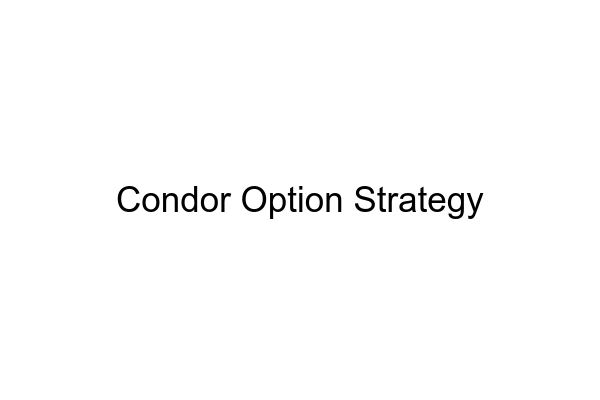Condor Option Strategy

What are the characteristics of this option strategy?
The Condor option strategy is a relatively low-risk, low-profit, neutral strategy. It has characteristics similar to a butterfly spread but generally involves both a call and a put option with different strikes but the same expirations. It is designed to take advantage of the narrow trading range in the underlying asset by opening both a long and a short option. The goal of the strategy is to generate profits when the underlying asset stays between the two strikes with the expiration of the options.
Is this a bullish, bearish, or neutral strategy?
The Condor option strategy is a neutral strategy, meaning it is designed to take advantage of a sideways trend in the underlying asset.
Is this a beginner or an advanced option strategy?
The Condor option strategy is an advanced strategy and requires a good understanding of the underlying asset and the dynamics of option trading. This strategy is not recommended for beginners.
In what situation will I use this strategy?
The Condor option strategy is typically used when the underlying asset is expected to remain within a fixed range for a set period of time but with low volatility. This strategy is popular among traders and investors who are risk averse since it generates profits when the underlying asset is trapped in a range.
Where does this strategy typically fall in the range of risk-reward and probability of profit?
The risk-reward and probability of profit of the Condor option strategy vary depending on the individual setup. Generally, this strategy tends to have a low risk-reward ratio and a low probability of profit.
How is this strategy affected by the greeks?
The greeks affect the Condor option strategy in the same way as other option strategies since the greeks measure the sensitivity of an option’s price to changes in different factors. For a Condor spread, the delta will be positive for the long options and negative for the short options, and the gamma and theta will also be affected.
In what volatility regime (i.e., VIX level) would this strategy be optimal?
The Condor option strategy is designed to take advantage of a narrow trading range with low volatility, so it is best used when the VIX level is low.
How do I adjust this strategy when the trade goes against me? And how easy or difficult is this strategy to adjust?
Adjusting the Condor option strategy when the trade is going against your position can be difficult since it requires understanding and anticipating the underlying asset’s movements. Generally, the more educated the trader is about the underlying asset, the easier it is to adjust the position.
Where does this strategy typically fall in the range of commissions and fees?
The range of commissions and fees for the Condor option strategy is similar to that of other option strategies since it involves opening multiple legs on both a call and a put option. Generally, the Condor option strategy is more expensive than other strategies because of the multiple legs.
Is this a good option income strategy?
The Condor option strategy is not usually used as an income strategy, as it generally has a low probability of profit. This strategy is usually used as a way to generate profits when the underlying asset is relatively stable and has low volatility.
How do I know when to exit this strategy?
The best way to know when to exit the Condor option strategy is to monitor the underlying asset’s movements closely and anticipate future movements. Traders should also be aware of when their options will be expiring in order to maximize profits and minimize losses.
How will market makers respond to this trade being opened?
Market makers will generally respond to the opening of a Condor option strategy by hedging their position and seeking to gain from the spread.
What is an example (with calculations) of this strategy?
An example of a Condor option strategy is one where you write a $265 call strike along with $245 put strike, anticipating range bound trade of MSFT in the range of $245 to $265. The trade is hedged by buying $275 strike call and $235 strike put. This strategy is usually used when the underlying asset, MSFT is poised to stay within the range of $245 to $265 with low volatility. In order to calculate the maximum profit and loss of this strategy, you should use an Iron Condor Excel Template, or the Short Iron Butterfly Explained Excel Template.
In conclusion, the Condor option strategy is a low-risk, low-profit, neutral strategy that can be used to take advantage of narrow trading ranges with low volatility. This strategy is best employed when the trader has a good understanding of the underlying asset, and should be backed up with calculations using relevant Excel templates. The understanding of how to adjust the position when the trade is going against it could be the difference between success and failure. MarketXLS offers a range of Excel templates to help traders with option trading calculations, and provides them with the necessary support when setting up and adjusting their positions.
Here are some templates that you can use to create your own models
Iron Condor Option Strategy
Call Condor Spread
Long Albatross Spread
Short Condor Spread
Reverse Iron Condor Spread
Reverse Iron Albatross Spread
Short Albatross Spread
Search for all Templates here: https://marketxls.com/templates/
Relevant blogs that you can read to learn more about the topic
“How Iron Condor and Strangle Options Differ”
Cut Complexity with Call Condor Spreadsheets
Maximizing Profits with a Bull Put Spread Strategy
Option Strategies For Professional Traders
Iron Condor Options Strategy – Video Explanation
